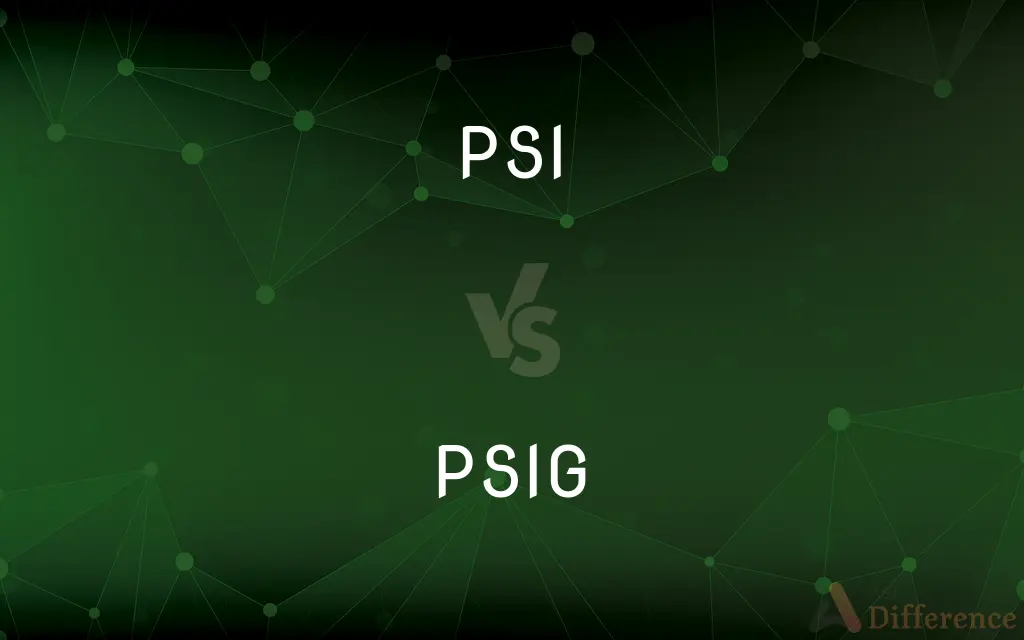PSI vs. PSIG — What's the Difference?
Edited by Tayyaba Rehman — By Fiza Rafique — Published on January 7, 2024
PSI measures absolute pressure, while PSIG indicates pressure above atmospheric pressure.

Difference Between PSI and PSIG
Table of Contents
ADVERTISEMENT
Key Differences
PSI stands for pounds per square inch, a unit of pressure in the imperial system. PSIG, which stands for pounds per square inch gauge, differs in that it references pressure relative to atmospheric pressure.
In the context of PSI, the measurement includes atmospheric pressure, which is about 14.7 psi at sea level. PSIG, on the other hand, subtracts this atmospheric pressure, providing a reading of only the pressure exerted beyond the ambient air pressure.
PSI is a broader term often used in scientific and engineering contexts. PSIG, however, is more specific and is typically used in applications like tire pressure, where only the pressure above atmospheric level is relevant.
When measuring with PSI, one could get a reading above 14.7 at sea level even in an unpressurized container due to atmospheric pressure. With PSIG, such a container would show a reading of zero, emphasizing the distinction between absolute and gauge pressures.
Comparison Chart
Meaning
Pounds per Square Inch
Pounds per Square Inch Gauge
ADVERTISEMENT
Reference Point
Absolute pressure
Pressure above atmospheric
Atmospheric Influence
Includes atmospheric pressure
Excludes atmospheric pressure
Usage
General pressure measurement
Pressure in closed systems
Sea Level Reading
About 14.7 psi at sea level
Zero at sea level
Compare with Definitions
PSI
Represents the force applied over a square inch.
The hydraulic press exerts a force of 2,000 PSI.
PSIG
Important in applications like tire pressure.
Inflate the tire to 32 PSIG.
PSI
A unit of pressure in the imperial system.
The pressure in the tank is 50 PSI.
PSIG
Common in engineering and mechanical contexts.
The compressor's output is 120 PSIG.
PSI
Used to measure pressure in various applications.
The car's tire pressure should be 35 PSI.
PSIG
Measures pressure relative to atmospheric pressure.
The pressure gauge reads 30 PSIG.
PSI
Also used in scientific calculations involving pressure.
The experiment requires a constant pressure of 10 PSI.
PSIG
Used where only excess pressure matters.
For this process, maintain the pressure at 5 PSIG.
PSI
The 23rd letter of the Greek alphabet. See Table at alphabet.
PSIG
Helps distinguish between absolute and gauge pressure.
The valve regulates the system to 20 PSIG.
PSI
Parapsychological phenomena or abilities considered as a group.
PSI
(countable) The twenty-third letter of Classical and Modern Greek and the twenty-fifth letter of Old and Ancient Greek.
PSI
A form of psychic energy.
PSI
A unit of pressure
PSI
The 23rd letter of the Greek alphabet
PSI
A standard unit for pressure in many industries.
The boiler operates at 150 PSI.
Common Curiosities
Is PSI the same as PSIG?
No, PSI measures absolute pressure, while PSIG measures pressure above atmospheric pressure.
What is the meaning of PSIG?
PSIG means pounds per square inch gauge.
Can PSI and PSIG have the same numerical value?
Yes, in a pressurized system, the numerical values can be the same if atmospheric pressure is not a factor.
Does atmospheric pressure affect PSIG readings?
No, atmospheric pressure is subtracted in PSIG readings.
What does PSI stand for?
PSI stands for pounds per square inch.
How is PSI used in everyday life?
PSI is commonly used to measure tire pressure, air pressure in tanks, and water pressure in pipes.
What tools measure PSI?
Pressure gauges, manometers, and sensors can measure PSI.
Is PSI used globally?
PSI is widely used, but some countries prefer the metric system (Pascals).
Where is PSIG typically used?
PSIG is often used in systems where only the pressure above atmospheric pressure is relevant, like in compressed air systems.
Does atmospheric pressure affect PSI readings?
Yes, atmospheric pressure is included in PSI readings.
What industries commonly use PSIG?
Industries like automotive, HVAC, and manufacturing commonly use PSIG.
How do you convert PSI to PSIG?
Subtract atmospheric pressure from the PSI reading to get PSIG.
Can PSIG ever be negative?
Yes, PSIG can be negative if the pressure is below atmospheric pressure.
Are PSI and PSIG used in science?
Yes, both units are used in various scientific contexts for pressure measurements.
Which is more common, PSI or PSIG?
PSI is more common in general usage, but PSIG is prevalent in specific applications like compressed systems.
Share Your Discovery

Previous Comparison
Notepad vs. Wordpad
Next Comparison
Social Science vs. HumanitiesAuthor Spotlight
Written by
Fiza RafiqueFiza Rafique is a skilled content writer at AskDifference.com, where she meticulously refines and enhances written pieces. Drawing from her vast editorial expertise, Fiza ensures clarity, accuracy, and precision in every article. Passionate about language, she continually seeks to elevate the quality of content for readers worldwide.
Edited by
Tayyaba RehmanTayyaba Rehman is a distinguished writer, currently serving as a primary contributor to askdifference.com. As a researcher in semantics and etymology, Tayyaba's passion for the complexity of languages and their distinctions has found a perfect home on the platform. Tayyaba delves into the intricacies of language, distinguishing between commonly confused words and phrases, thereby providing clarity for readers worldwide.













































